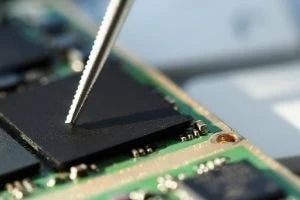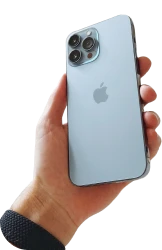MacBook Air Logic Board Replacement

After spending money on a reputable, well-known device, like the MacBook Air, you most likely use it quite a bit. As reliable as this MacBook model is, it’s not free from a common but severe issue, known as logic board failure. If your logic board starts malfunctioning, it can render your laptop unusable. Read CPR’s step-by-step guide explaining how to undertake a MacBook Air logic board replacement yourself.
Do You Need to Perform MacBook Air Logic Board Replacement?
A MacBook’s logic board is another word for a motherboard. It sends communication signals between the laptop’s inner electronic components, including the central processing unit and memory. Operating as one of the most critical hardware elements, the logic board is often overworked. Over time, it’s not uncommon for it to eventually need a repair or replacement.
Unfortunately, given the huge workload placed on the logic board, there’s no definite sign pointing to internal failure. It often takes a little bit of research and digging to identify the problem. Typically, most users experience excessive laptop overheating. However, any of these symptoms can signal logic board malfunctioning.
Power Problems and Unanticipated Shutdowns
An Apple MacBook Air failing to power up is a key indicator of a faulty logic board. However, this issue can also point to battery problems. One way to tell the difference between them is to check if it turns on after plugging in your power cord. If plugging it in solves the problem, you probably have a dead battery. If not, it’s more than likely a damaged logic board.
Graphic and Display Issues
Faulty graphics and display issues can also result from logic board failure. Even if your laptop’s fan is running, the logic board can still cause the backlight to malfunction, resulting in poorly lit, or a lack of display images. To know what the cause is for sure, try connecting an external monitor to your computer. If the issue persists, your logic board is likely the problem.
Other Issues
Apart from power and display issues, there are still other common indicators of logic board failure. You may see frequent error messages popping up on-screen, requiring a reboot. Additionally, your laptop’s fan can suddenly stop running, even if you’ve been using it for hours.
If not working correctly, your logic board may even start producing new and unusual sounds, such as grinding or clicking noises. Still, these signs alone can’t rule out other laptop issues. It’s best to seek out professional help if you’re unsure.
What Causes a Logic Board to Fail?
As mentioned previously, there are several reasons your MacBook Air’s logic board can break. Manufacturing defects, a weakened solder, and liquid damage are common causes. Still, even something as small as accidentally dropping your laptop or the age of your MacBook Air can lead to logic board failure.
How Much Does it Cost to Replace a MacBook Air Logic Board?
Logic board replacement costs can vary, depending on which route you choose to take. We strongly advise taking your device to a reputable service provider. While it is possible to complete this procedure yourself, a professional technician can ensure the job gets done thoroughly and promptly. Plus, you won’t need to go through the headache of buying additional tools and equipment yourself.
Apple Store Service Costs
If you bought your laptop in the last couple of years, Apple might cover your MacBook logic board repair service under their warranty. Newer MacBook Air Models, MacBook Pros, iMacs, Mac Pros, and Mac Mini models come with a limited one year warranty and 90 days of complimentary support. Air models under warranty typically require $200-$300 for logic board repairs. Unfortunately, if your laptop is out of warranty, you’ll have to invest a bit more. Expect repair costs to add up to around $500-1,000.
CPR Cell Phone Service Costs
If your laptop isn’t covered under Apple’s warranty, consider choosing Cell Phone Repair as your logic board repair provider. Our technicians are fully trained and only work with only quality replacement parts to fix your device. Plus, our stores offer free repair estimates and limited lifetime warranties on all repairs as an added convenience.
DIY Costs
If you’re set on repairing your laptop yourself, you won’t have to worry about service charges. However, you will need to purchase all the necessary tools and equipment in advance. DIY logic board replacement costs for a MacBook Air can range anywhere from $150-500, depending on the model of your laptop. If you’re unsure of what model you own, locate your serial number using Apple’s MacBook Air identifier.
Your DIY MacBook Air Logic Board Replacement Guide
With the right tools and steps taken, a MacBook Air logic board replacement can be completed at home. Make sure you’re setting aside enough time to complete the project. When you’re ready, gather up a spudger and P5 Pentalobe screwdriver, and follow along using the steps below.
Double-check that your laptop is unplugged and powered-off before you get started.
- Start by grabbing your Pentalobe screwdriver to take out the ten screws located on your laptop’s bottom.
- Position your fingers in-between the laptop screen and the lower case. Gently pull upwards to pop off the lower case. After you’ve removed the case, set it to the side.
- We recommend taking out your battery to prevent your laptop from powering on during the remaining steps.
- Take the plastic pull tab positioned on the battery connector and pull it carefully towards the logic board at the front end of your MacBook.
- Now, take the flat of a spudger and pry the I/O cable connecter from its socket onto the I/O board.
- Gently peel your laptop’s I/O board cable apart from the adhesive that holds it to the top part of the fan. Ensure this cable is in proper position during reassembly. If reversed, your laptop cannot boot up.
- As you’re carefully pulling the I/O board cable up towards the logic board, take the flat end of your spudger and pry upwards on the alternating connector ends to remove it from the socket. Then, take out the I/O board cable.
- With the tip of your spudger, gently flip the retaining flap up onto the fan cable ZIF socket. Make sure you’re prying on the hinged retaining flap, rather than the socket.
- Peel the gasket off from the adhesive located on the top part of the fan.
- Next, take out these screws that hold the fan to the upper case.
- 5.2 millimeter T5 Torx screw
- 3.3 millimeter T5 Torx screw
- 4.4 millimeter T5 short head Torx screw
- Remove the fan away from the I/O board side. Then, pull and free it from the upper case. Lifting the fan will additionally disconnect the fan ribbon cable, so make sure it doesn’t snag.
- Detach the I/O board by removing the power cable away from the socket located on the logic board. Pull so that the cable is parallel to the logic board’s face towards the right corner on the laptop.
- Taking the spudger’s flat end, pry the left speaker cable connector out from its socket and onto the I/O board. Make sure you pry underneath the wires, going upwards.
- Use the spudger’s tip to gently flip the retaining flap upwards onto the microphone ribbon cable ZIF socket. Check to ensure you’re flipping the flat and not the actual socket.
- Take off the single 4.1 millimeter T5 Torx screw
- Carefully, de-route the I/O board’s camera cable and use the spudger’s tip to push it to the side.
- Now, take the I/O board from the logic board side and free it from the upper case by pulling gently.
- Take out these five screws holding the battery to the upper case:
- Three 6.9 millimeter T5 Torx screws
- Two 3.0 millimeter Torx Screws
- Liftoff the battery from the edge closest to the logic board, and remove from the case.
- Now, it’s time to assemble the logic board. Take the plastic pull tab fastened to the display data cable lock, and start to pivot it towards the top side of your MacBook.
- Next, take the display data cable connector away from the socket. Make an effort to pull it parallel towards the logic board, and do not lift straight up.
- With the flat end of your spudger, pry the antenna cable connectors out from their sockets and onto the AirPort/Bluetooth card.
- With the spudger’s tip, detach the camera cable connector. Push on each end of the connector separately to gently take it out of the socket. To prevent the logic board from breaking, make sure you don’t pull upwards when you disconnect the cable.
- Using the spudger’s tip or your fingernail, flip the retaining flap upwards on the trackpad ribbon cable ZIF socket. Make sure you’re not prying on the flap, rather than the actual socket. Take the trackpad ribbon cable out from its socket and towards the front side of the laptop.
- Using the spudger’s tip again, flip up the retaining flap on the keyboard backlight ribbon cable ZIF socket, and ensure you’re not prying on the socket. With your spudger, lightly pull the keyboard backlight ribbon cable from its socket.
- Pry the right speaker cable connector out of the socket with the spudger’s flat end. We recommend prying up from underneath the cables.
- Now, take out the six Torx screws holding the logic board to the upper case.
- Then, take out the inner two T8 Torx screws that secure the left clutch and antenna cable retainer to the upper case.
- Slightly advance the antenna cable retainer away, and take out the T5 Torx screw holding the end of the heat sink to the case.
- Next, you’ll want to loosen the adhesive on the front end of the laptop. To do so, take the flat end of the spudger and slide it underneath the right speaker. Then, extract the right speaker from the case.
- Cautiously transfer the logic board assembly out of the upper case, making sure cables are not getting caught.
- Then, extract the single 2.85 millimeter T5 Torx that’s holding the SSD to the logic board.
- Remove the drive from the logic board by pulling it straight out of its socket.
- Take out the single 2.9 T5 Torx screw holding the Airport/Bluetooth board to the logic board.
- Lightly, raise the free end of the AirPort/Bluetooth board, and remove from its socket on the logic board. Take the AirPort/Bluetooth board out of the logic board.
- Extract the four 2.5 millimeter T5 Torx screws holding the heat sink onto the logic board.
- Then, take the heat sink out from the logic board.
- Finally, ensure the antenna cables are properly inserted into their corresponding notches on the logic board.
- To reassemble your laptop, refer to these instructions, and follow them in reverse order.
At CPR, We understand the intricacy involved in logic board replacements. If you need help with a MacBook repair, don’t hesitate to contact us. Our repair shop professionals are fully trained in fixing a variety of Apple products, ranging from MacBooks, iPads, iPhones, and more. To get started, find your local CPR store and book your appointment today!
MORE ON Microsoft Surface Pro 4
WHAT CUSTOMERS ARE SAYING
Dralyndra Quincy
I went in and told him what was going on with my son's phone and he was able to fix it and show me what was wrong with it . Very nice and friendly staff as well great job I will be going back if I have any other problems.
B Fit
Fast and professional service, they told me 1 hour but it was done in 30 minutes, excellent service from Davit and Jillian.
Ben Dyar
Did a great job in one hour. Decent price

